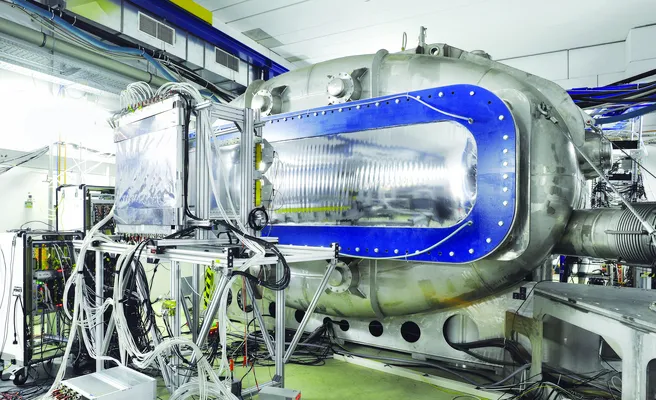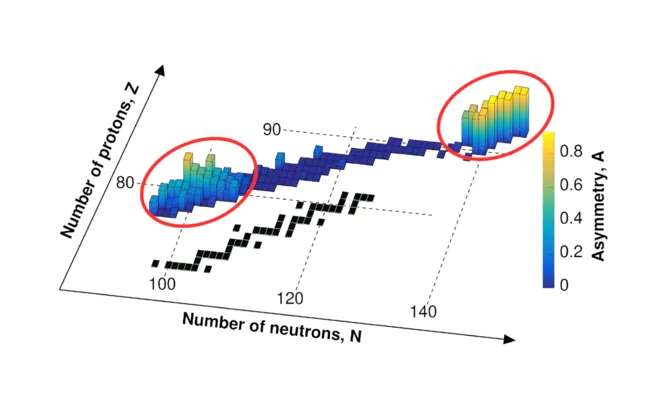The chart of nuclides is of similar importance to nuclear physics as the periodic table of elements is to chemistry. All known atomic species (nuclides) and isotopes can be represented graphically on the so-called table or chart of nuclides. Isotopes are atoms with the same number of protons but different numbers of neutrons. Nuclear fission is a reaction in which an atomic nucleus splits into two or more smaller nuclei. If the fragments have different masses, this is called asymmetric fission. The collaborative projects "Reactions with Relativistic Radioactive Beams" and "Studies on Nuclear Fission with GLAD" (R3B/SOFIA for short) discovered and mapped a new island of asymmetric nuclear fission for atomic nuclei in the region of mercury. The scientific journal Nature recently published the results.
Recreate the formation of elements in the Universe
The diversity of elements in the Universe arises through various mechanisms. The r-process is crucial for forming heavy elements: the rapid capture of neutrons by atomic nuclei. Core-collapse supernovae generate the required high neutron densities, allowing atomic nuclei to quickly capture neutrons and thus form heavy elements. If the newly formed isotopes are unstable, they transform further through radioactive decays or nuclear fission.
On Earth, the formation of heavy elements can be simulated in laboratory experiments. For example, the GSI/FAIR (Facility for Antiproton and Ion Research) in Darmstadt enables scientists to study fission properties under controlled conditions.
An international team, including researchers from the Technical University of Munich, investigated the fission properties of 100 different, neutron-deficient exotic isotopes ranging from iridium (with a proton number of Z = 77) to thorium (Z = 90). Isotopes with a low neutron-to-proton ratio can be generated by fragmenting a relativistic uranium-238 primary beam at 87.6 percent of the speed of light. The GSI Fragment Separator (FRS) then allows separation and identification of the isotopes. Directing the isotopes onto a segmented lead target in the R3B setup and exciting them to a few megaelectronvolts above their ground-state energy can induce fission into two lighter fragments. The TWIN-MUSIC double ionization chamber then enables the charges of both fission products to be measured. In addition, the large superconducting dipole magnet GLAD on R3B sorts the fission fragments according to their momentum-to-charge ratio. Using large-area detector arrays, the researchers could record the fission products, measure their flight times, and reconstruct the reaction dynamics.
Towards understanding terrestrial and cosmic fission
During the ten-day experiment, the team collected several terabytes of data. They reveal a transition toward increasingly asymmetric fission in neutron-deficient, heavy nuclei. This marks the discovery of a new island of asymmetric fission in the nuclide chart, characterized by a surprising dominance of light fission fragments with atomic number Z = 36 — the proton number of krypton. "Beyond mapping this novel phenomenon, our findings enhance our understanding of terrestrial and cosmic fission processes," says lead author Pierre Morfouace of the CEA/DAM/DIF and the Université Paris-Saclay.
Furthermore, the results provide valuable points of comparison for theoretical models, significantly improving their predictive power for the distribution of fission fragments in neutron-rich systems. This is relevant for nuclear energy applications and r-process nucleosynthesis in the cosmos. "This is a major step forward in our understanding of the expected fission recycling in supernova explosions, which feed element production in our Galaxy," says ORIGINS researcher Roman Gernhäuser from TUM and technical coordinator of the R3B experiment.
Next steps
This discovery is the first step in identifying a newly observed region in the nuclide chart where asymmetric fission dominates. The researchers plan further follow-up experiments at FAIR, which will soon begin operation with the "Early Science" campaign. The centre piece will be the new superconducting fragment separator (Super-FRS), a major upgrade and successor of the currently operating FRS. The Super-FRS is intended to enable the selection and delivery of even rarer and more exotic isotopes. The researchers hope to map the new island of asymmetric fission in more detail and uncover fundamental aspects of nuclear matter under extreme conditions.
Publication
- P. Morfouace et al., An asymmetric fission island driven by shell effects in light fragments. Nature, 10.1038/s41586-025-08882-7
More information and links
- ORIGINS https://www.origins-cluster.de/en/
- ORIGINS Principle Investigator Dr. Roman Gernhäuser
Contact about the article
Dr. Roman Gernhäuser
TUM School of Natural Sciences E62 / ORIGINS Exzellenzcluster
roman.gernhaeuser@ph.tum.de
Press contact
Original press release: https://www.origins-cluster.de/en/news-events/news/detail/new-island-of-asymmetric-fission-discovered-on-nuclide-chart

